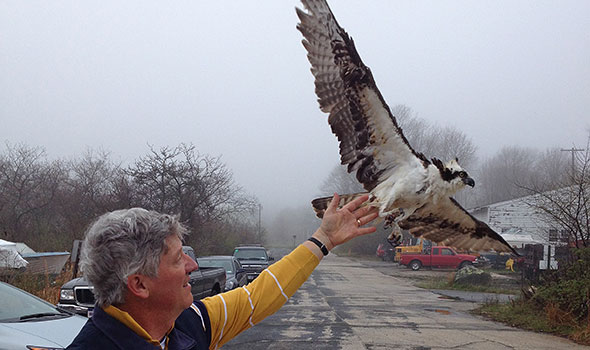By Pierce Rafferty, Director Henry L. Ferguson Museum
Rob Bierregaard, Research Associate of the Academy of Natural Sciences of Drexel University in Philadelphia, returned to Fishers Island on April 29th at the invitation of the Henry L. Ferguson Museum. Rob’s goal was to “tag” a second male osprey on Fishers Island with a cell tower transmitter, having successfully tagged male osprey “Edwin” last May.
Rob and a small group of interested helpers spent a wet, cold and generally miserable day on April 30th repeatedly failing to trap the male osprey at Money Pond. The target bird landed three times on the trap, but didn’t move his talons enough to become entangled in the fish-line filament slip nooses that covered the top of the trap. Although the male eluded trapping, the female was caught and had been previously banded. Rob reported in his on-line blog: “I’m claiming a case of severe brain freeze as my excuse for not writing the numbers of the band down correctly. When I submitted the number to the Bird Banding Lab, I was informed that that band number was never issued. Oops. So we did some detective work and tracked down the data from the late Jerry Mersereau, who banded Ospreys in neighboring Connecticut for decades. It turns out that Jerry tagged a young Osprey in 1996 with a band number that was just two dyslexic twitches from the number I wrote down. That would make the bird 19 years old. Old for an Osprey, but not the record. There’s an Osprey in Scotland who is 27 years old now and has fledged 50 young in her long and storied career!”
We were far more successful on Thursday, May 1st, Day 2. Working in the morning fog, Rob quickly trapped an osprey on the nest at the west end’s Transfer Station. It was unclear if the bird in hand was the male or the female. About one half hour later, the captured osprey’s mate returned to the nest. Markings and size quickly revealed that she was the female. She too was caught in the trap as she returned to her four eggs. (We later learned from a more careful transcription of her band that she was a 15 year old bird banded as a nestling in Ct.) With the sex of our first bird no longer in doubt, the female was released while Rob and helpers worked on strapping a one-ounce, solar-powered transmitter to the male osprey’s back. Please note that the males are more useful for the current round of tagging because ornithologists are most interested in charting their hunting patterns and feeding locations. Females are generally nest bound while raising young.
The HLFM would like to thank David Burnham of the Race Rock Garden Company for his support in providing a bucket truck and an operator on short notice. Jared Barber of Race Rock did a great job as operator. We would also like to thank Gordon Murphy of the Fishers Island Ferry District, Chris Finan of the Fishers Island Utility Co. and Mike Conroy of the F.I. Telephone Co. for their help. The following individuals provided much appreciated assistance during the trapping process: John Ski, Tim Patterson and Ken Edwards. Finally, we would like to give special thanks to John and Nick Spofford and the M.W. Spofford Foundation for providing the financial support that made this project possible.
We are also most appreciative of the ongoing research that Richard O. “Rob” Bierregaard, Jr. conducts involving ospreys and other raptors and hope that “Charlie” contributes useful data to his efforts. Rob’s website can be found at www.ospreytrax.com.


